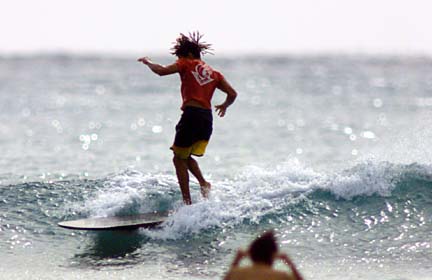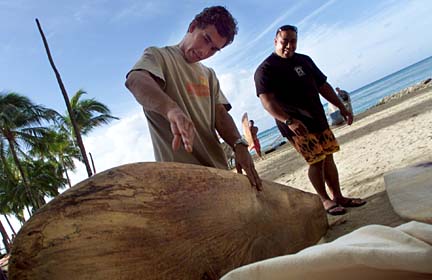
CINDY ELLEN RUSSELL / CRUSSELL@STARBULLETIN.COM
Duane DeSoto, left, and Destry Flores checked out the longboard that Hawaiian Beach Boy Willie Grace took out for a ride at Waikiki yesterday. Grace said: "It's almost like taking you back to day one. It's different. Real different."
Surfers at Kuhio Beach get
a taste of how Duke rode waves
About 20 surfers sought out the roots of their sport yesterday at Kuhio Beach, surfing on old-style, wooden boards like they did in the old Waikiki of Duke Kahanamoku.
And they hope it's just the beginning of a revived interest in pii mai ka nalu, surf-riding.
Using 10- and 12-foot surfboards made of wiliwili and mango wood that weigh more than 100 pounds and have no skegs, there were no quick turns or hot-dogging moves.
But when the surfers caught a wave, they rode it with an elegance of days gone by.
"It's different. I have a newfound respect for the ancestors," said Destry Flores, 36, after his first-ever session with a wooden board.
It took him five tries to get a ride because he had to learn a new timing for catching the wave with the heavier board, he said.
Even though his two rides on less than 1-foot waves were short, they were sweet.
CINDY ELLEN RUSSELL / CRUSSELL@STARBULLETIN.COM
Domingo Beddingfield surfed on a vintage wooden longboard yesterday. The heirloom was brought to the Hawaiian Longboard Federation event by Warren Ho'ohuli. "It was a once-in-a-lifetime experience," he said.
"I was thinking, 'This is neat. I'm enjoying myself,' and I was just going with the ride," Flores said.
Most participants yesterday, like Flores, had never seen, much less used, a wooden board before.
"It's been a dream of mine to put on an event like this," said Diane Johnson, president of the Hawaii Longboard Federation. "We'd like to introduce the world to the Hawaiian cultural aspect of surfing. We want to remind people of where it came from."
Many beachgoers yesterday seemed oblivious to the small event. But others were drawn to the wooden boards leaning against a low rock wall, stopping to ask questions about them.
The federation plans to hold similar events on Maui and the Big Island in January and February, though exact times and places haven't been set. Members hope to hold an annual Old Hawaii Wooden Surfboard Series in the islands and maybe eventually take demonstration trips to California, Florida, even Japan.
"It isn't about the waves themselves," said event organizer Tom (Pohaku) Stone, who shaped a board for the event and encouraged others to do the same. "It's a Hawaiian tradition, that's what it's really all about. It's an opportunity to paddle on something you have only heard about in books."
CINDY ELLEN RUSSELL / CRUSSELL@STARBULLETIN.COM
Duane DeSoto and Destry Flores admired a mango longboard at Queen Liliuokalani's Break in Waikiki. DeSoto helped harvest the trees used to make the traditional wooden longboards.
Stone, a former professional surfer and a Hawaiian Studies professor at Kapiolani Community College, estimated that Waikiki may not have seen a wooden board since the 1950s.
Doc Pascowitz, a longtime California surfing instructor who now lives in Waikiki, was thrilled to happen upon the event on his way to surf yesterday afternoon. Citing his age, he decided not to surf on the heavy boards, but praised the concept.
For Stone, 52, the event was something of an atonement for his behavior as a 6-year-old when his father gave him a handmade wooden board.
"I was a bratty kid. I wanted a store-bought board, but my dad couldn't afford it," Stone recalled. Before his father died in 1997, Stone said he apologized for not appreciating what his father had done for him.
"It's definitely a unique experience," said participant Dean Nakamaru. "Because the board is a lot heavier, it forces you to really plan. When you turn for a wave and paddle for a wave, everything has to be done sooner. It forces you to switch gears and slow down."
"It's a lot heavier and it's harder to paddle," said Taio Shipman, 27, after a turn on a wooden board. "The whole thing's different -- a different aspect of surfing. It's great being down at Waikiki and great to be able to learn to surf like they used to."
Warren Ho'ohuli brought out an old family board, passed down from his grandfather's father, lovingly oiled it with kukui oil and took it out for a few rides.
Duane DeSoto, honored for overall best performance in the event, said, "The best thing about this is that our children will be able to surf these boards and become stronger people."
Kaipo Kanahele, originally of Niihau and now of Nanakuli, shaped a mango board for the event. "Surfing is my passion," he said. "And I wanted to reimmerse myself into my culture."
Duke would have been proud.
To learn more
For more information about the Old Hawaii Wooden Surfboard Series, contact Diane Johnson at 381-9763 or HLFhawaii @aol.com.



